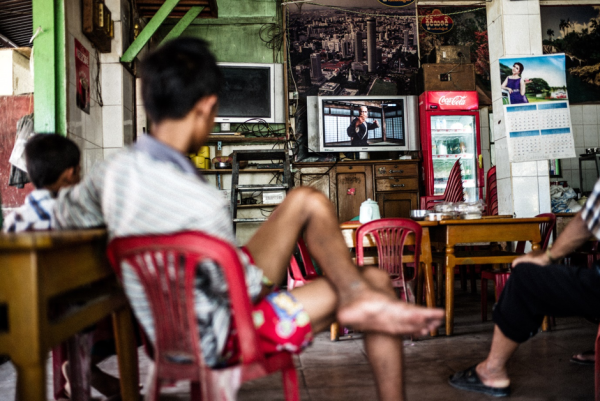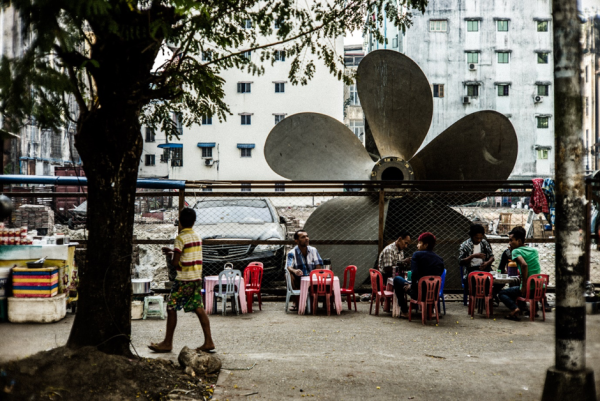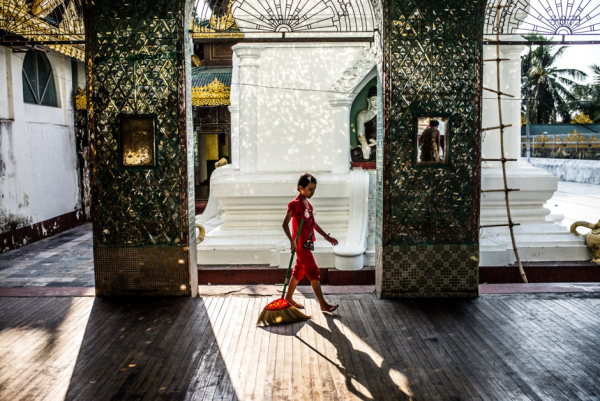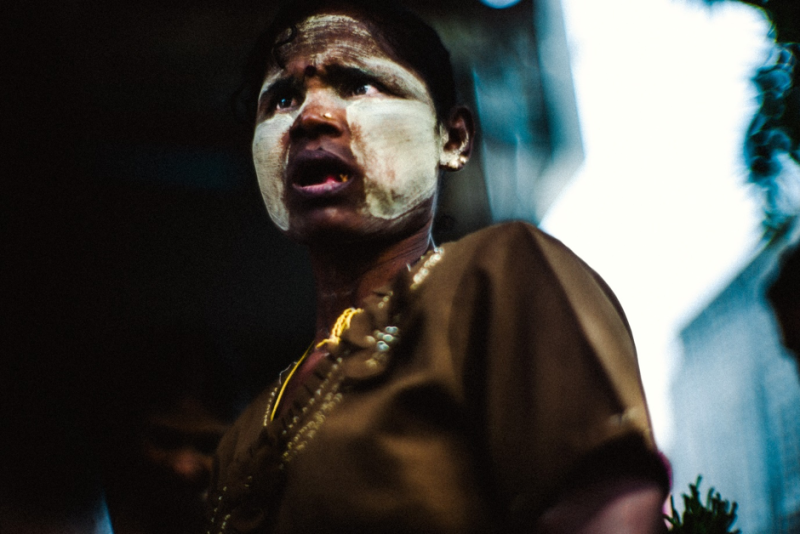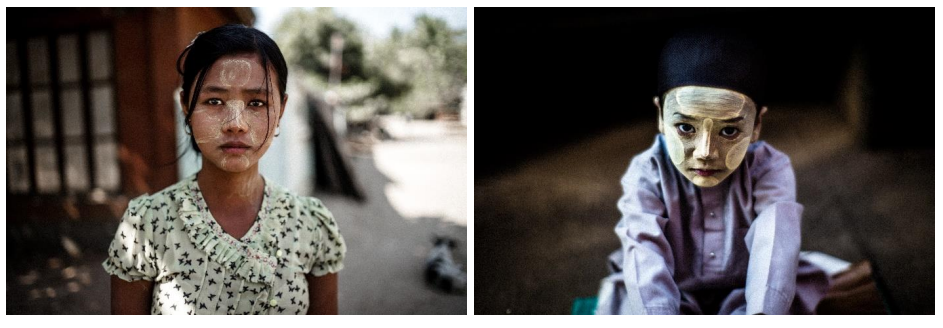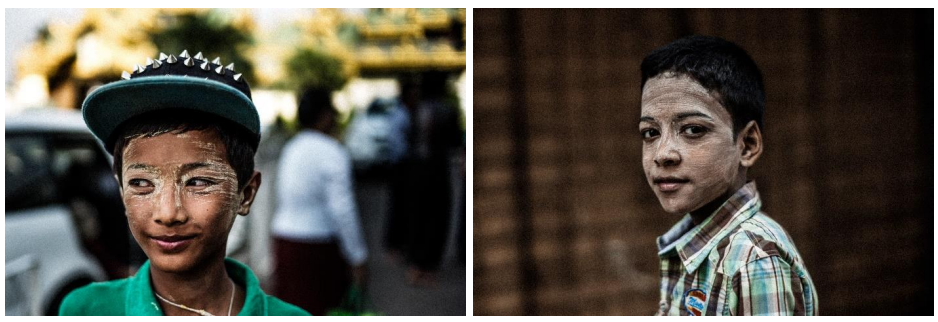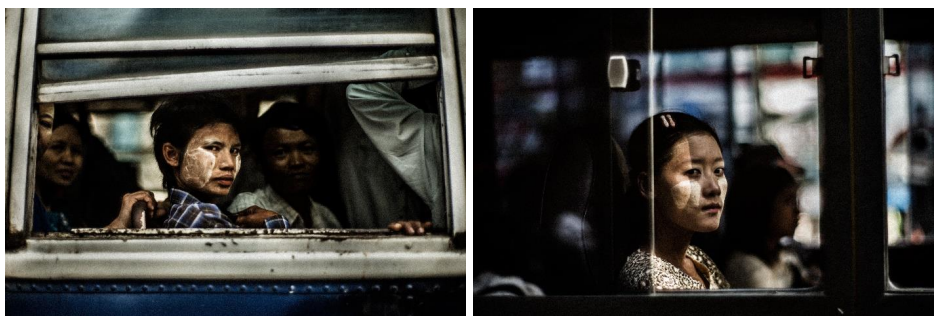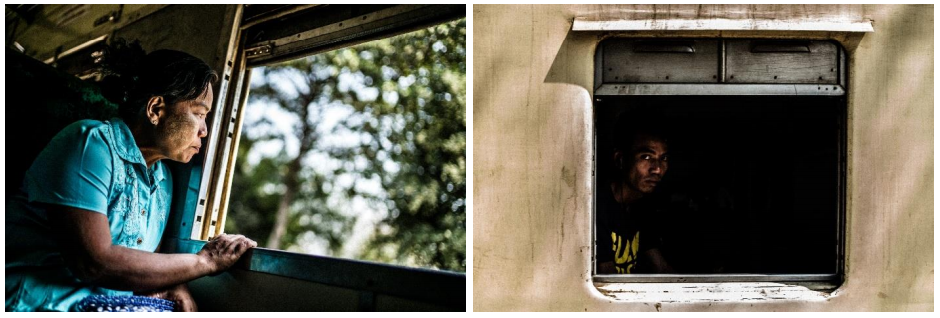Much of the discourse surrounding Myanmar discusses its struggles with identity formation as an obstacle to its otherwise huge potential for growth and development (Dittmer, 2010) (Perry, 2007). After decades of isolation, Myanmar emerged out of its cocoon only to find itself bombarded with questions of how authoritarian or democratic the country should be, how the ethnic minorities should be accommodated, and how to move forward as a nation in general with a laundry list of problems that stunt its development. However, this paper operates on completely different premises: that Yangon, the old capital of Myanmar, does in fact have a firm grasp of its identity, and that development is not necessarily a desirable process.
Daniel Zvereffe, an independent photographer, frames development quite differently. In the blurb accompanying his online album of Yangon titled ‘Chinthe’, he notes the influx of ‘foreign investments and 21st century products into a culture that had, essentially, been frozen in time’. He concludes by saying, ‘Despite this abrupt transition into modernism, the sincere, beautiful people remain unchanged from the first encounter I had with the country years ago’. His album then seems to posit that development can be contested, and probably should be, in order to preserve authenticity and a certain beauty of place. From Zvereff’s photographs, I could not help but be attracted to this stubborn streak that Yangon apparently has. What does Yangon’s resistance to development look like, and how does Zvereff present this? After a thorough examination of his photographs, it is clear that they capture how Yangon stubbornly resists the inherently fast and dynamic force of development by capturing ‘slowness’.
Development can generally be understood as the process of upgrading economic, physical, and social infrastructure to support economic growth. The imperative of economic growth means that there is always a philosophy of utility behind development: if something does not support growth, it should be revamped. Spurred by slow economic and social development yet faced with a rapidly growing population, the Japanese International Cooperation Agency (JICA) developed the Greater Urban Development Plan for Yangon. According to JICA’s annual report (2013), the master plan for Yangon has four central elements: ‘to make Yangon an international hub city, a city where residents can live with ease, a city with a sound infrastructure, and a city that is well governed’ (p. 72). However, implicit in JICA’s goal of making Yangon an ‘international hub’ is the speed and dynamism global cities tend to be associated with (Lindner & Meissner, 2015, p. 7). Apart from a characteristic dynamism, rapidly globalizing cities also display a condition of anonymity or invisibility of individuals (p. 7). Such ‘social estrangement’ is accentuated in cities as space is partitioned to fit the needs of the city, creating social divisions at the same time (Marcuse & Kempen, 2000, p. 20). Additionally, the process of development may erode the cultural identity of a heritage city in favour of the cosmopolitan identity of a global city (Lindner & Meissner, 2015, p. 6). It is no secret that development comes with its own baggage of negative implications, and JICA has rightly acknowledged this in its report (2013, p. 72).
Rising in opposition to today’s culture of speed is the culture of ‘slowness’. And because slowness rises precisely to oppose a culture of speed, it finds its greatest expression where the pace of life is particularly quick, in contemporary global cities (Lindner & Meissner, 2015, p. 4). It can manifest in a variety of forms, whether intensity of boredom, interruption of everyday rhythms, prolongation (p. 8), and it has culminated in movements like the slow food movement. These movements have the common ‘desire to resist the accelerated pace of contemporary life in order to promote values and concepts such as community, sustainability, justice, roots, quality, and belonging’ (p. 8). In the case of Yangon, slowness is not an organised movement. Yet, Zvereff has managed to candidly capture it in its varying forms in his photographs, creating an album that represents Yangon’s resistance to the relentless force of development. My analysis of his photographs is centred on the idea that slowness has different modalities (p. 9) and can be identified as stillness, ordinariness, mundanity and so on.
Historically, Yangon has always been a site of struggle, and while Myanmar may grapple with its national identity, Yangon is clearly a city of resistance. It was in Yangon that students, the nationalist Thakin party, and politicised workers came together to drive out British colonial powers (Seekins, 2005, p. 257). Fifty years later, it was in Yangon that the people of Myanmar staged the 8888 demonstrations that brought the collapse of a repressive regime (p. 257). Evidently, Yangon’s stubborn streak persists through time and continues to weave its way into the fabric of the present. Today, Yangon simply continues this legacy by resisting a force no less totalitarian: the force of development. However, this time, Yangon resists quietly: by simply being slow.
Resistance in the form of slowness can be seen in Zvereff’s photographs on two levels: on the level of the medium and on the level of content. That is, slowness can be extracted from the subject matter of Zvereff’s photographs, but also from the very fact that they are photographs. Photography as a medium is in itself slow and resistant to the dynamism of development due to its inherent stillness. Since its earliest days, photography has been prized for its capacity to ‘still movement and time’ (Lindner & Meissner, 2015, p. 15). Although photographs can capture energy, mobility, and dynamism, that these things are ultimately condensed into a static medium makes photography innately opposed to the dynamism of development. As Yangon undergoes a major facelift in the coming years, its physical landscape is sure to change, but Zvereff subjects Yangon to a stillness by etching a static memory of the city through his photography.
Street photography and portraiture are two genres that feature most prominently in Zvereff’s album. These genres seem to stand in opposition to each other: in street photography, photographers work without being noticed by their subjects to capture candid pictures of everyday life in the street (Westerbeck & Meyerowitz, 1994, p. 34). In contrast, in portrait making, the photographer and subject are generally completely aware of each other’s presence and even ‘exhibit a formal stillness’, as both portraitist and subject compose themselves to ‘indicate the solemnity of the occasion and the timelessness of the portrait image as a…statement, summing up ‘a life’’ (Brilliant, 1991, p. 10). Nonetheless, I find it natural that these two genres are used together in Chinthe because they both have the capacity to capture essences of places and people in order to resist anticipated change arising from development.
Street photography tends to exploit the instantaneity of photography (Westerbeck & Meyerowitz, 1994, p. 34) to capture actions as they are in the thick of being done, or to capture the fleeting ‘decisive moment’. This instantaneity is usually reflected in the element of motion blur. On the contrary, Zvereff’s street photographs depict slowness by highlighting activities that have little to do with the fast-paced movement of labour and commodities in a global city. Zvereff chooses instead to depict some of the most mundane activities of our daily lives that fall into ‘slower’ categories of watching (Figure 1), leisure (Figure 2), or sweeping (Figure 3). Thus, his photographs lack the conventional motion blur.
Figure 1 Boys casually watching television
Figure 2 Men having drinks
Figure 3 Girl with broom
Additionally, his street photographs capture slowness, because they depict empty, aged spaces wholly devoid of the hustle and bustle of a global city. These buildings are on the verge of disappearance considering JICA’s explicit goal of making Yangon a city with ‘sound infrastructure’ (2013, p. 72). Yet, Zvereff reclaims them by photographing them in all their rusty glory (Figures 4 and 5). These photographs therefore disrupt development with their blatant display of buildings that actually show no activity, directing our attention to them when they might have been overlooked due to their lack of utility.
Figure 4 Dilapidated building, Figure 5 Entrance to a dilapidated building
Zvereff’s portraits, on the other hand, decelerate the dynamic interaction in a global city by redirecting our attention to the singularities who inhabit Yangon. While many people in cities communicate with many others at different times of the day, portraits oblige a one-on-one engagement between viewer and subject that requires time and effort. Images of busy masses of people are all too familiar as images of the city. However, Zvereff’s photographs capture a single subject (Figures 6 to 8), reminding us to slow down and engage with individuals who still exist but may be overshadowed by the metropolitan city they live in.
Figure 6
Figures 7 and 8
Furthermore, Zvereff’s subjects are often captured seemingly doing nothing. In this way, none of his portraits depict a flat character—characters ‘constructed round a single idea or quality’—or who are confined to a place and time where and when they became a person worth remembering (Brilliant, 1991, p. 140). Faced with subjects who are not flat, viewers do not merely take a cursory glance, but go on to wonder who Zvereff’s subjects are and why they have been captured. If as viewers of Chinthe we become visitors to Yangon, then we also become acquainted with the people of Yangon via Zvereff’s photos, overcoming the potential ‘social estrangement’ that could occur in a globalizing city’s ‘new spatial order’ (Marcuse & Kempen, 2000, p. 3). By spurring engagement between what would otherwise be two strangers, his photographs pose a huge contrast to the anonymising effect of development that renders not only the inhabitants of Yangon a cog in the machine, but the visitors to Yangon another face in the crowd. In other words, his photographs have the capacity to facilitate the development of a relationship between subject and viewer. His portraits are slow because most of his subjects are commonly understood to be excluded from the fast flows of globalization (Lindner & Meissner, 2015, p. 17), such as children (Figures 8 to 11), women at home (Figure 7) (Parkins, 2004, p. 367), and monks (Figure 11).
Figures 9 and 10
Figure 11
In addition, a significant number of his subjects are in trains (Figures 12 to 15). From the earliest railways to today’s fast bullet trains, trains and transportation are very much an index of the advancement in technology that enables life to become faster and faster. Yet, the passenger is a conundrum: no matter how fast transportation grows, the passenger remains still through time, passively carried away in a rapidly moving cabin. The passenger on the train is then an example of slowness, in the form of immobility even within mobility.
Figures 12 and 13
Figures 14 and 15
Zvereff’s portraits also capture slowness by asserting the cultural identity of the people of Myanmar over a more cosmopolitan one, which could easily emerge as Yangon becomes an ‘international hub’. The marker of cultural identity seen in most of Zvereff’s portraits is the thanaka unabashedly smeared on his subjects’ faces (Figures 6 to 10, 12 to 14). Thanaka is the Burmese name for Limonia Acidissima, or sandalwood, a tree common in Southeast Asia and indigenous to Myanmar (Goldsberry, Dinner, & Hanke, 2014, p. 306). The pulverised bark of thanaka has been used as a cosmetic product in Myanmar for over 2000 years, with its first mention traced back to ancient Burmese lyrics (p. 306). Furthermore, despite tension between local Buddhists and Muslims, thanaka is worn by people of all faiths (Levin, 2014). Wearing thanaka is an age-old practice unique to Myanmar that is a highly visible mark of people’s heritage and culture.
In relation to this, slow movements are very much about promoting and asserting local culture. The aim of the slow food movement that originated in Rome was to ‘oppose the spread of standardised fast food, promoting instead the local, sustainable…production of high quality food’, while defending traditional regional cuisine (Tomlinson, 2007, p. 146). Similarly, the slow city movement that emerged from Orvieto embraces the preservation of traditional economic and cultural practices in order to promote distinctive characteristics of traditional, slow paced, small town life – città lente (p. 146). From these, we can see the common thread of preserving local culture as a reaction to standardisation and speed. The prominence of thanaka in Zvereff’s portraits is then unmistakably a proud expression of Myanmar’s cultural identity. Nonetheless, this pride is quiet and dignified, with his subjects captured not in pomp and poise, but in their everyday ordinariness, as if emphasising that thanaka is by no means a luxury, but rather an everyday necessity that will stand the test of time and the force of development.
Chinthe does include some seemingly anomalous photographs that are neither portraits nor street photographs. For example, Zvereff includes a photo of a tattooed arm holding a cigarette (Figure 16) and another close-up photo of what appears to be beheaded fish (Figure 17). Slowness in the form of an assertion of cultural identity and preservation of traditional practices may explain these photographs. Apparently, tattoos, considered a form of protection, are common in predominantly Buddhist countries like Myanmar. Thus, they could be another marker of Yangon’s cultural identity. Similarly, fishing is a primary economic activity in Myanmar that has been done for years. Perhaps a photograph of fish commemorates this long-held practice that might be seen as rural as Yangon transforms into a global city.
Figure 16 Tattooed arm resting and holding a cigarette, Figure 17 Bloody, beheaded fish
Regardless of what these photographs may or may not mean, they remind us to look for resistance even in our most everyday actions and objects. From the fish in the local market to the powder we use on our faces, we may also be passively resisting the modern force of development. If anything, Chinthe shows us that resistance does not always have to be loud. It can be slow, quiet, and yet equally firm in its position.
Bibliography
Agency, J. I. C. (2013). Economic infrastructure development. Japan: Japan International Cooperation Agency.
Brilliant, R. (1991). Portraiture. Cambridge: Harvard University Press.
Dittmer, L. (2010). Burma or Myanmar?: The struggle for national identity. London: World Scientific.
Dixson, A. D., Chapman, T. K., & Hill, D. A. (2005). Research as an aesthetic process: Extending the portraiture methodology to qualitative inquiry. Qualitative Inquiry, 11(1), 16-26.
Goldsberry, A., Dinner, A., & Hanke, W. (2014). Thanaka: Traditional Burmese sun protection. Journal of Drugs in Dermatology, 13, 306-307.
Levin, D. (2014). Where ancient Burmese beauty balm competes with modern cosmetics. The New York Times. Retrieved from http://www.nytimes.com/2014/07/29/world/asia/where-ancient-burmese-beauty-balm-competes-with-modern-cosmetics.html?_r=0
Lindner, C., & Meissner, M. (2015). Slow art in the creative city: Amsterdam, street photography, and urban renewal. Space and Culture, 18(1), 4-24.
Marcuse, P., & Kempen, R. V. (2000). Introduction. In P. Marcuse & R. V. Kempen (Eds.), Globalizing cities: A new spatial order? (pp. 1-21). Oxford: Blackwell.
Parkins, W. (2004). Out of time: Fast subjects and slow living. Time & Society, 13(2-3), 363-382.
Perry, P. J. (2007). Myanmar (Burma) since 1962: The failure of development. Hants: Ashgate Pub Company.
Seekins, D. M. (2005). The state and the city: 1988 and the transformation of Rangoon. Pacific Affairs, 78(2), 257-275.
Tomlinson, J. (2007). The culture of speed: The coming of immediacy. London: SAGE.
Westerbeck, C., & Meyerowitz, J. (1994). Bystander: A history of street photography (Vol. 1st). Boston: Little, Brown.

